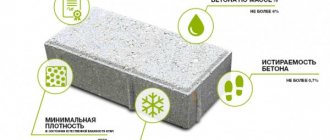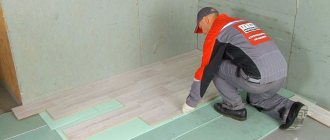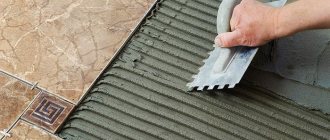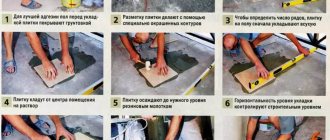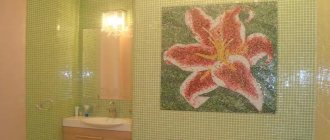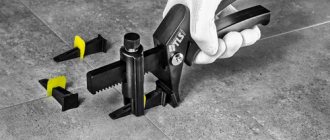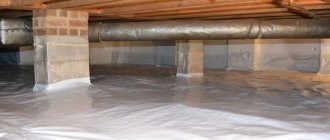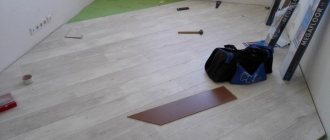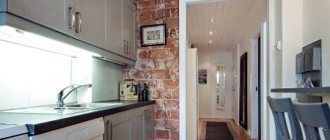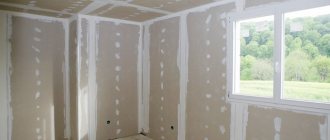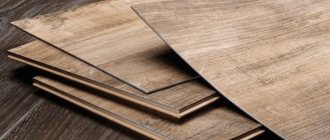New floor coverings are constantly appearing on the modern market, which successfully compete with traditional materials such as wood or ceramic tiles. One of these coatings is vinyl laminate; it appeared relatively recently, but quickly gained fame and popularity.
What are PVC tiles?
PVC tiles are a multi-layer floor covering, the production of which involves the hot pressing method, without the use of glue or resins. This feature of the production process ensured the safety of the product for human health.
Vinyl tiles have a PVC base, and quartz or chalk is used as a binding element. The outer polyurethane layer provides the coating with reliable protection from mechanical stress and ultraviolet radiation. Depending on the brand, the design of the tiles may vary, as each manufacturer introduces its own developments aimed at improving the properties and quality of the material.
Thanks to this structure, quartz vinyl has a lot of advantages:
The coating is recommended for installation in the bathroom, corridors, kitchen, balconies and living rooms, and is also excellent for commercial premises.
Warm floors and PVC tiles - what to put on heated floors?
Floor heating systems are becoming increasingly popular today. For many, this is an opportunity to get a comfortable covering under their feet, while others even make a “warm floor” the main source of heating in the house, which can significantly reduce costs during the heating season.
How to implement heated floors if you want the floor covering to be PVC tiles There are various heating systems, and the range of PVC tiles is very wide. What to choose? We were not too lazy to interview PVC coating manufacturers and put together the requirements and advice for laying PVC tiles on “warm floors”.
The need for a substrate
To understand whether a backing is needed for PVC tiles, you should familiarize yourself with the types of coatings in accordance with the installation method:
Despite the manufacturer’s recommendations to carry out the installation process without using a substrate, consumer demand for these products gradually increased, which is due to a number of factors:
Taking into account the above requirements, the range of brands has been supplemented with a special backing for PVC tiles. Distinctive characteristics of the product are increased rigidity and thickness within 1-1.5 mm. This underlay provides stability to the floor covering, preventing it from “walking,” which guarantees the safety of the locks. Despite the unique development, the manufacturer’s recommendations regarding the installation process still indicate that the level difference over two meters of length cannot exceed 2 mm.
Advantages and disadvantages
Due to the presence of a large number of advantages, vinyl laminate flooring successfully competes with many traditional coverings. Among its advantages it is worth noting the following:
- the presence of a large selection of colors and patterns, which allows you to imitate any materials;
- ease of cleaning and maintenance;
- vinyl laminate is waterproof, so can be used in the bathroom, kitchen or similar areas;
- it is comfortable to walk on, it is warm and soft;
- low cost;
- high strength;
- good maintainability;
- ease of installation.
Despite the fact that manufacturers indicate only the positive characteristics of vinyl laminate, like any other material, it has a number of disadvantages:
- the presence of chemicals in it can cause irritation of the mucous membranes and respiratory diseases, usually this occurs during the first time after installation of such a coating;
- this material is not biodegradable, therefore, after its service life expires, it pollutes the environment;
- non-renewable natural resources are used to produce vinyl laminate;
- the surface of the subfloor must be smooth and free of debris, since the presence of solid particles leads to damage to the vinyl coating;
- traces from heels or rubber mats can cause a chemical reaction, resulting in discoloration of the material;
- it is not possible to restore such a floor; if damaged, it must be replaced;
- over time, a low-quality coating may turn yellow;
- When burned, it releases toxic substances.
Types of substrates for PVC tiles
As already mentioned above, to lay polyvinyl chloride tiles you need a special substrate from a series of high-density ones. There are five varieties of such products on the market; we will consider each of them in detail.
Thermoplastic substrate
The base is dense polyethylene or propylene. The products are presented in rolls or in the form of an accordion. Experts recommend products that have a layer of vapor barrier and heat reflector. The ease of installation is due to the presence of a valve on one side and an adhesive strip on the other, due to which it is possible to firmly and reliably fasten the cuts.
Modified extruded polystyrene foam
A distinctive feature is its high-density structure. You can buy the substrate in the form of mats or “accordion” with a heat-reflecting layer; the thickness of the material varies between 1-1.8 mm.
Ethylene vinyl acetate is based on synthetic rubber, which provides the bedding with thermal insulation properties and elasticity. Installation specialists recommend buying EVA with a thickness of 1-1.5 mm. This group of substrates includes a combined series of IXPE bedding, made on the basis of polyethylene and foamed EVA.
Polyurethane with mineral fillers on a non-woven or PET base
This group of underlying materials belongs to the expensive segment and is characterized by increased weight and longer service life. The products are marketed in rolls with a super-dense structure; the thickness can vary between 0.8-2 mm.
There are two types of polyurethane with non-woven and PET bases on the market:
Backing for quartz vinyl tiles with a lock - a whim or a necessity
Quartz vinyl tile is a multilayer finishing material made from a mixture of PVC, mineral filler, stabilizers, pigments and other components. The products belong to modular finishing products and are available in the form of:
Obviously, the first type does not need an underlying layer. And the question about the need for lining for the last two types of coatings will be answered by installation instructions from the manufacturers. It is indicated on the packaging, on manufacturers’ websites, in brochures and inserts that a backing for quartz vinyl interlocking tiles is recommended. That is, the condition is not categorical, so the purchase depends on the operating conditions and is left to the discretion of the buyer or installer.
FACT! The thickness of the lining for vinyl and quartz vinyl coatings is standard - from 1 to 2 mm.
For composite cladding, the lining is needed not only as a damper, but also as a partial heat and sound insulator. Intermediate layer:
It is worth noting that the substrate practically does not smooth out serious irregularities. It only works for small point sagging or microdifferences of 0.2-0.3 mm. We remind you that quartz vinyl tiles are a semi-rigid material with a certain degree of elasticity, “fluidity”. When installed on a floor with soft differences (without sharp slopes), it will actually take the shape of the base and smooth out the “air pockets”. Not everyone likes this result, because all the shortcomings of the base layer appear.
The backing for quartz vinyl interlocking tiles is not recommended:
Note that all types of vinyl and composite coverings can be glued to the base. This allows you to minimize the movement of the laminate as a result of climatic changes, prevents the opening of the end locks and the formation of cracks in the floor.
Manufacturers recommend using adhesive fixation if installation is carried out:
Laminate from leading manufacturers
Today on our market you can find products from German, Japanese, South Korean, Belgian, Chinese and domestic manufacturers.
Laminate manufacturers
Fine Floor
The products of the Belgian manufacturer are considered the standard of quality. Laminate is produced in three factories. If initially only adhesive quartz-vinyl coating was produced, then since 2013, interlocking material has appeared in the Fine Floor line. Today, consumers are offered 5 collections of laminate flooring, the textures of which imitate various types of natural stone and wood. New types of products are constantly being developed.
Laminate Fine Floor
Laminate is available in 34 and 43 classes. Its dimensions:
- thickness from 2.5 to 5 mm;
- width 190…329 mm;
- length 650…1326 mm.
Fine Floor (Belgium)
Prices for quartz-vinyl laminate Fine Floor
Quartz-vinyl laminate Fine Floor
AquaFloor
The Belgian plant produces coatings of wear resistance class 43, which allows it to be used in premises for various purposes. The interlocking cover is 9 mm thick. It does not absorb water either in droplet or vapor form. The manufacturer's line includes 11 collections.
Laminate AquaFloor
Prices for quartz-vinyl laminate AquaFloor
Quartz-vinyl laminate AquaFloor
Armstrong
Imperial Texture Tiles Armstrong DLW, produced in Canada, are characterized by excellent performance properties. It can be installed in schools, kindergartens, higher educational and medical institutions, in administrative and commercial premises, including evacuation zones.
Armstrong coating
The thickness of the tile is 3.2 mm. Size - 30.5 x 30.5 mm.
Armstrong quartz-vinyl laminate prices
Armstrong quartz vinyl laminate
DECORIA
The production of laminate was established at the South Korean plant back in 1979. Interlocking quartz-vinyl tiles have wear resistance classes 42 and 43. It is produced in dimensions of 1210 x 169 mm and a thickness of 4.3 mm. A protective layer of 0.5 mm ensures durability of the coating even in difficult operating conditions. The factory has established a twenty-five-year warranty on the products.
Laminate DECORIA
Table. Comparison of laminate from some manufacturers.
| Manufacturer | Formaldehyde emission | Thermal conductivity, W/mK | Wear resistance, class | Slip resistance |
| AquaFloor | E1 | 0,15 | T | R9 |
| Fine Floor | E1 | 0,25 | T | R10 |
| Armstrong | E1 | 0,17 | T | R10 |
The Russian-German company Tarkertt Art Vinil offers a huge selection of panels with high moisture resistance and wear resistance
The new coating, produced from quartz sand and vinyl, today competes with traditional finishing materials.
Types of substrate for quartz vinyl
While underlayment under composite decking is not required, it is desirable in some cases. But you don’t need standard coniferous, polystyrene, cork or isolon, but a specially designed one from a series of high-density ones. Available in 5 types:
Thermoplastic lining
It is made of dense polyethylene or polypropylene in the form of an accordion or a roll cut. Most often, construction markets offer specialized products with an integrated vapor barrier and heat-reflecting layer (FineFloor UnderFloor Silver Line, Quick Step Comfort15, Arbiton Secura LVT Click Smart, etc.). The product is easy to install because there is a valve on one side and an adhesive strip on the other. This makes joining the cuts very easy. It is enough to attach the layers end-to-end, remove the protective paper on the tape and glue them together. Price – from 290 RUR/m2.
Modified extruded polystyrene foam bedding
Unlike classical products, the bedding for PVC coverings is characterized by its low thickness (1-1.8 mm) and high-density structure. It is made in the form of mats (Solid under SPC/WPC/LVT, Alpine Floor Green) or “accordion” with a thermo-reflective layer (Solid Anti-slip, Planker LVT/SPC). Price – from 90 RUR/m2.
EVA backing (ethylene vinyl acetate)
The synthetic rubber underlay material is relatively new, but very warm and resilient. For LVT and quartzinyl coatings, manufacturers offer products made from high-density EVA with a thickness of 1-1.5 mm (Pavitec PRO EVA, Alpine Floor Silver Foil Blue EVA).
This group also includes the combined IXPE series - a mix of a polyethylene base and foamed ethylene vinyl acetate (Vinyflex IXPE, Aquafloor IXPE LVT). The price of rubber products is from 160 rubles/m2.
Polyurethane backing with mineral fillers on a non-woven or PET base
The most expensive, heaviest and most durable type of underlying materials. Rolled products have a super-dense structure, thickness from 0.8 to 2 mm. Available in two varieties:
Combined cork covering
For composite coatings, manufacturers recommend using specialized products for vinyl floors, for example, Fargo Refloor, etc. However, the most interesting product from Amorim is a mixture of cork granulate and EVA foam rubber. It is produced under different trademarks of the concern: Cork4U LVT Unique, Go4Cork Cycle Vapour Barrier, etc. The product is. Rolled litter is dense, elastic and antistatic. Price – from 350 RUR/m2.
All types of substrates, according to manufacturers, can be used with base heating systems. Although in the assortment of some brands you can find special series for “warm floors”, for example, Quick Step HEAT10 or Pergo Vinyl SunSafe LVT.
Finally, we’ll tell you why you can’t use a regular substrate like isolon, polystyrene foam and others. It's all about too much thickness and low density of the lining. During use, the tiles sag, and the locks don’t just come apart - they break due to strong play. This, unfortunately, is a fact proven by bitter experience. The photos below prove that the denser the underlying layer, the shorter the connection stroke and the longer the service life of the coating.
Do you think a backing is needed for quartzinyl tiles? Share your opinion in the comments.
Advice! If you need floor repair specialists, there is a very convenient service for selecting specialists from PROFI.RU. Just fill out the order details, the experts will respond and you can choose who to collaborate with. Each specialist in the system has a rating, reviews and examples of work, which will help with the choice. Looks like a mini tender. Placing an application is FREE and does not oblige you to anything. Works in almost all cities of Russia. Without your desire, no one will see your phone number and will not be able to call you until you yourself reveal your number to a specific specialist.
If you are a master, follow this link, register in the system and be able to accept orders.
Source
What kind of underlay to lay under vinyl and quartz vinyl laminate?
Vinyl laminate is a material designed for flooring. It is usually used in kitchens, bathrooms, and bathrooms. It is not affected by moisture or aggressive environments. A room with such flooring becomes cozy and comfortable, and the PVC finish lasts a long time.
But to ensure durability during installation, certain conditions must be met. The main one is the installation of a substrate for the laminate.
Coating features
Thanks to its multilayer structure, quartz-vinyl laminate has a fairly long service life and can perform its function for more than 20 years, which is one of the main advantages. This coating also has a number of distinctive features, which makes it popular in residential, office and administrative premises:
- Wear resistance - laminate is not subject to abrasion and deformation.
- Simplicity of installation - all work on laying the coating can be done even by an untrained person.
- Increased flexibility - the material is easy to process, so cutting and aligning edges will not cause any difficulties.
Why do you need a substrate?
It is necessary to install the underlayment because vinyl laminate is a material that is flexible and thin. Because of this, if the floor is uneven, even minor, it can be easily damaged.
When the substrate is arranged, the irregularities disappear. The PVC laminate adheres tightly to the base over the entire area. Due to this, the pressure, which is provided by the weight acting on the lamellas, is distributed evenly. The coating is not damaged.
When choosing an underlay material, it is necessary to take into account that it should protect the laminate from the influence of the base layer from which the floor is made. It could be concrete, fiberboard.
It is necessary to take into account the existing humidity, temperature, as well as the condition of the surface itself - the presence/absence of unevenness and differences in height.
Types of underlays for vinyl laminate
Cork
A good effect is ensured by a cork backing. It is made by pressing crushed cork oak bark. With its help, a high degree of sound insulation is ensured.
In addition, it retains heat well. The downside is that it cannot be used where there is high humidity.
It is also undesirable to use cork in rooms located above bathrooms and toilets. The same can be said about cases where a screed was applied to the floor surface relatively recently.
But in panel houses, cork underlay for vinyl laminate is applicable almost without restrictions.
The main condition for installation is that the base base should not have any unevenness. Otherwise, the laminate will deform.
Polyethylene
The next optimal type of substrate for PVC laminate is polyethylene (isolon). The material is characterized by low cost.
Foamed isolon has a thickness of 2-3 millimeters. Under the pressure of the fiberboard covering, it contracts, thereby compensating for unevenness on the floor. This backing reliably protects against moisture, ensuring the safety of the laminate.
Expanded polystyrene
Another, no less positive way to provide protection to vinyl laminate is with polystyrene foam backing. It can be used where heavy loads are possible on the floor.
Difficulties may arise during installation. The fact is that polystyrene foam is hard. It doesn't level the surface well. This means that the floor should be thoroughly leveled before starting work.
But the material also has good positive qualities. Laid in one layer, it provides reliable protection from moisture and has a high degree of thermal insulation.
Tuplex
Tuplex underlay perfectly compensates for uneven floors. It also retains heat well and provides sound insulation. It is characterized by low toxicity and durability. Being elastic, Tuplex can be easily installed in places where access is difficult.
Coniferous
This is an environmentally friendly, natural material that provides the maximum degree of thermal insulation. If the room is dry and the floor is concrete, then a coniferous underlay is one of the best options.
The coniferous underlay guarantees good sound insulation and compensates for minor unevenness in the floor. When installing an electric heated floor, it ensures uniform heating.
What is vinyl laminate?
Manufacturers praise this material, and if you listen only to them, it turns out that it has extremely positive qualities.
To understand this, let's take a closer look at what PVC laminate is, what advantages it has, and does it have any disadvantages? Vinyl laminate is a floor covering made from polyvinyl chloride . This material can be purchased in the form of tiles, panels or in rolls.
If we talk about the parameters of the panels, they usually have dimensions of 191x1316, 324x655 mm, and tiles have dimensions of 300x150, 300x300, 200x200, 490x490 mm. A special feature of this floor covering is its small thickness , usually it does not exceed 5 mm. This allows vinyl laminate flooring to be laid on a solid old base, and the height of the room is reduced slightly.
The specified floor covering consists of the following layers:
- adhesive layer, if there are locking connections, it may be missing;
- The heat-insulating substrate is also not available in all models of this coating;
- polyvinyl chloride base;
- fiberglass serves to ensure the flexibility of the coating and protect it from tearing;
- fiber optic layer;
- the printed image allows you to create different shades and structures;
- a layer of transparent PVC protects the material from damage;
- polyurethane layer;
- Treatment with ultraviolet rays increases the light resistance of the coating.
Substrate for quartz vinyl laminate
When installing self-adhesive or adhesive quartz vinyl tiles, you can do without a backing. But, when it is necessary to provide good sound or thermal insulation, Xtrafloor™ Flex PRO is usually laid.
Due to the presence of glue on its surface, the floor can be used immediately after completion of the work. At the same time, the thickness of the substrate ensures leveling of the surface with unevenness of up to two millimeters.
When laying interlocking quartz vinyl tiles, the installation is quite quick. If necessary, use Xtrafloor Base or Xtrafloor Flex Pro.
Due to its high thermal conductivity, the first one – Base – can be used to install underfloor heating systems. It provides good sound insulation. It also does a good job of leveling floors that have minor unevenness.
Source
Preparing the base
To lay laminate flooring, the subfloor must be carefully prepared:
- The surface of wooden floors must be leveled, and the load-bearing elements must not move freely. If there are rotten or deformed boards, they should be replaced with new ones.
- Concrete floors must first be well puttied, which will allow you to get rid of minor defects. If there are serious problems, it is best to fill the floor surface with screed, which will give a flat floor surface.
- Stone or tile floors require caulking between the tiles.
Experts recommend laying sheets of plywood under the laminate, or installing a cement-sand screed, which allows you to obtain a flat surface. If there are irregularities, the laminate will be deformed, so its service life will be significantly reduced.
Do I need an underlay for vinyl laminate flooring and what kind?
You have chosen vinyl laminate flooring, but you are unsure whether an underlay is needed. In the case of classic laminate, there is no such question - it is definitely necessary. But with vinyl laminate the situation is different.
When laying adhesive-based laminate flooring, as well as when laying vinyl, an adhesive backing is not required. An underlay is required when laying interlocking laminate and laminate with smart tape.
Since vinyl laminate with a locking joint is the best-selling and popular, next we will look at the types of underlays for vinyl laminate with a locking joint.
What you need to know when choosing a substrate
- Some vinyl laminate flooring comes with a built-in backing and does not require additional underlayment.
- It is simply prohibited to use foam backings for some types of laminate; you need to check with the seller or manufacturer.
- The choice of substrate depends on the type and brand of laminate; you need to choose based on the manufacturer’s recommendations.
- The choice of underlay should be taken no less seriously than the choice of laminate, because the durability of your future floor covering depends on it.
You can find out all these subtleties from the specialists of the Doka store or on the website of the manufacturer of a specific brand of vinyl laminate.
If you are in doubt about choosing a vinyl laminate underlay, you can always contact the specialists of our store for qualified advice. We will help you make the right choice.
Which underlay is best to choose for vinyl laminate?
Vinyl laminate is quite flexible and, with a small thickness, can be damaged on an uneven floor. Therefore, a substrate comes to the rescue, hiding slight differences and cushioning the main surface. In addition, the substrate serves as additional noise and heat insulation.
The choice of underlay for vinyl laminate depends on factors such as:
Main types of substrates and their features.
1. Cork backing
can only be used on a perfectly flat floor, has good heat and sound insulation properties. The main disadvantages of installing under vinyl laminate flooring is that it has a slippery surface, which causes the locks to come apart. Cork backing cannot be used in rooms with high humidity.
2. Expanded polystyrene backing
quite rigid, which complicates installation a little, but it can and should be used where additional loads or heavy furniture are expected on the floor. Expanded polystyrene protects well from dampness and moisture, and also has high thermal insulation properties. The thickness should not exceed 1.5 mm.
3. Backing for interlocking tiles
PVC (LVT) Arbiton Secura LVT Click Smart 1.5 mm. Ideal for vinyl laminate flooring. Provides additional
thermal insulation of the floor, evens out small differences, increases acoustic comfort. Suitable for use with screed underfloor heating systems. Suitability, compatibility and installation methods when used with infrared film floors (mats) are determined by the installer and/or supplier of the specific underfloor heating. Optimally selected density and non-slip surface of the substrate prevent horizontal divergence of the PVC tile locks. The longitudinal edges of the substrate are equipped with adhesive tape and overlap. Checkered markings are applied to the surface for an even cut.
All types of substrates will serve as protection much longer if used on a perfectly flat surface. Using an underlay does not mean that it will take over all the unevenness of the floor. The subfloor must be thoroughly prepared and leveled before installation.
Instructions for laying interlocking quartz-vinyl tiles “Click-Drop”
Instructions for laying adhesive quartz-vinyl tiles Instructions for laying interlocking quartz-vinyl tiles "Dream-Click" Instructions for laying interlocking quartz-vinyl tiles "Click-Drop" Instructions for laying interlocking quartz-vinyl tiles "Click-Click" Installation instructions LVT tiles Matrix IVC Commercial 70
This instruction is suitable for the lock collections: FineFloor Strong
FineFloor Wood FineFloor Stone FineFloor Rich
Contents:
1.
Preparation for laying interlocking quartz-vinyl Fine Floor -
Drop interlocking system 1.1. Rules for transportation and storage of packages 1.2. Requirements for the base 1.3. Recommendations for preparing the base 1.4. Requirements for the room where installation will take place 1.5. State building codes
2. Tools required for installation.
3. General instructions for laying
Fine Floor interlocking quartz-vinyl tiles with the Click-Drop interlocking system 4.
Rules for
Fine Floor interlocking quartz-vinyl tiles Drop interlocking system in a free-lying (“floating”) way
4.1 . Preparation for installation 4.2. Start of installation 4.3. Laying the covering 4.4. Laying tiles in doorways, around heating pipes and complex interior elements 4.5. Laying the last row
5. Rules for laying interlocking quartz-vinyl
Fine Floor Drop interlocking system on an adhesive-fixer
5.1 General instructions 5.2 Applying an adhesive-fixer
6. Rules for laying
interlocking quartz-vinyl tiles Fine Floor Drop interlocking system on heated floors
7. Rules for the care and operation of interlocking quartz-vinyl tiles
Fine Floor
7.1 Operation 7.2 Care
1. Preparation for laying interlocking quartz-vinyl
Fine Floor -
Drop interlocking system 1.1.
Rules for transportation and storage of packages. ·
Packages must be stored and transported by carefully placing them on a flat horizontal surface.
·
It is prohibited to place packages vertically (on their end).
·
Do not store packages in places with high humidity.
·
Before installation, the purchased flooring must be kept in the room where installation will take place. Packages must be in a horizontal position in stacks no more than 15 packs high at a temperature from +18°C to +24°C for 24 hours.
1.2. Foundation requirements.
The base for quartz-vinyl tiles must be:
· Level
: the maximum permissible difference in height of the base surface is 2 millimeters per 1 linear meter;
Unevenness, stepped changes, pits and tubercles are unacceptable; · Monolithic
: cracks, breaks and voids are unacceptable;
the integrity of the base structure is necessary; · Clean
: before installation, you must carefully remove all debris and remove dust from the base, make sure there are no spills of construction fluids, oil stains, etc.;
· Dry
: moisture content rate in cement screed without heating ≤ 2%, in cement screed with heating ≤ 1.8%, in anhydrite screeds (calcium sulfate) without heating ≤ 0.5%, in anhydrite screeds (calcium sulfate) with heating ≤ 0.3%, in woody base ≤ 12%;
· Non-dusting
: it is unacceptable to use a loose base that forms new dust;
· Solid
: the base should not deform from applied loads, in particular pressure from furniture legs, etc. Quartz-vinyl tiles are a plastic material and transfer point loads completely to the base.
1.3.
Recommendations for preparing the base: ·
Old floor coverings (laminated parquet, parquet, cork and carpet, linoleum, PVC tiles, etc.) must first be dismantled.
·
It is advisable to dismantle ceramic tiles.
If this is not possible, then it is necessary to fill the floor with ceramic tiles with a specialized leveling compound according to the relevant instructions. ·
The wooden base made of boards must be covered with sheet materials with a thickness of 10 mm (moisture-resistant plywood, OSB, tongue-and-groove chipboard), securing them with self-tapping screws in increments of 250 mm, according to the technology for fastening sheet materials.
·
When installing a base made of sheet materials on joists, sheets (moisture-resistant plywood, OSB, tongue-and-groove chipboard) must be laid in two layers “in a staggered manner”, secured with self-tapping screws in increments of 250 mm.
According to the technology of fastening sheet materials, the joints of the sheets of the lower layer are overlapped “overlapping” with the sheets of the upper layer. ·
All recesses from self-tapping screws and sheet joints must be filled with non-shrink putty and sanded.
·
If necessary, level the existing dry concrete base with a cement-based finishing floor leveler.
1.4.
Requirements for the room where installation will take place. ·
during installation of the floor covering, the air temperature in the room should be from +18°C to +24°C;
·
the temperature of the base (floor) within 24 hours before installation and 24 hours after its completion should not be lower than +15°C;
·
maximum permissible air humidity in the installation room: 70%;
·
the “warm floor” system must be turned off 24 hours before installation.
1.5 State building standards.
·
Installation conditions must comply with applicable government regulations and standards.
·
If government regulations and standards conflict with these instructions, the more stringent rule must be followed.
2. Tools required for installation.
·
roulette;
·
metal square;
·
pencil;
·
bladed construction knife;
·
chop cord or laser level;
·
rubber hammer or special rolling roller;
·
jig/tamping device (possibly made from scrap tiles).
Fine Floor interlocking quartz-vinyl tiles Drop interlocking system .
3.1.
Fine Floor quartz-vinyl tiles with the Click-Drop connection system are a free-standing floor covering, during installation of which, as a rule, there is no need to glue it or otherwise fix it to the base.
But there are special cases when installation using adhesive-fixer for quartz-vinyl floor coverings is required, with fixation over the entire surface of the base, or the installation of additional expansion joints, which are closed with a joining profile (threshold): · when laying in a single room with a length or width exceeding 8 meters
requires fixing the floor covering to the base or installing additional expansion joints;
· when laying in a single room with an area of more than 64 m2,
it is necessary to fix the floor covering to the base or install additional expansion joints
· when laying in rooms of complex geometric shape
, with a large number of corners, columns, it is necessary to fix the floor covering to the base or install additional expansion joints;
· when laying in commercial or public premises,
it is necessary to fix the floor covering to the base, regardless of the area of the room;
· when laying in two or more rooms without expansion joints
(without thresholds) in doorways, it is necessary to fix the floor covering to the base, regardless of the area of the room.
· when laying in rooms filled with heavy furniture
more than 50% of the total area, heavy furniture located along one or more walls of the room without gaps.
Important! Partial gluing of quartz-vinyl tiles is prohibited, for example, gluing along the perimeter or in certain areas of the room.
3.2.
Before installation, you should carry out a visual inspection of the coating to identify deficiencies, damage, defects or deviations from the characteristics declared by the manufacturer:
·
Make sure that there is no external damage to the packaging;
·
Check that the color, article number, batch number and quantity of the purchased product matches your order.
It must be taken into account that the coating may differ slightly from the sample, since slight deviations in color shades on the material of different batches are acceptable; ·
In one room it is recommended to use coating from one production batch, which is indicated on the end of the package;
·
During installation, check each tile from the package for visible defects or other defects.
Important! Do not install flooring with identified defects!
3.3.
To cut tiles, you should use a specialized construction blade knife. Using a knife, cut the top protective layer from the face of the tile, then bend the tile along the cut. If necessary, cut through the tile from the back side.
3.4.
There is no need to adjust the pattern when joining tiles. At the same time, avoid placing two tiles with the same decorative elements next to each other.
3.5.
When laying, maintain a thermal gap around the perimeter of the room, when joining with other floor coverings, around all pipes, columns, etc. from 5 to 10mm.
3.6.
The use of a substrate when installing interlocking quartz vinyl is not necessary. But if you decide to use an underlay, it must be designed for use with quartz-vinyl flooring. The thickness of the substrate should be no more than 2 mm. The underlay used must have sufficient compression resistance (at least 400 kPa) to prevent the floor covering from being pressed through.
Important!
If you have not found the answer to your question in these instructions, contact the Fine Floor Group by toll-free number 8.
Fine Floor interlocking quartz-vinyl tiles Drop interlocking system -lying (“floating”) way .
4.1.
Preparing for installation. ·
Before starting installation, it is necessary to evaluate the geometry of the room, for example, whether all angles correspond to 90°, whether opposite walls are parallel, whether there are any curvilinear deviations of the walls.
Based on the geometry of the room, it is necessary to think in advance about the optimal placement of the tiles in order to avoid unnecessary costs of material for trimming. ·
Also, when choosing the laying direction, you should take into account the location of the light source (window). As a rule, when laying on deck, the long side of the tile is laid perpendicular to the plane of the window opening (in the direction of light). When laying diagonally, there is no need to take into account the light source.
4.2. Start of installation.
Draw a center line (using a tapping line or laser level) from which to begin laying the quartz-vinyl Fine Floor tiles
.
As a rule, installation begins from the most visible area of the room. The center line can be parallel to the walls or selected according to the design features of the room.
4.3.
Laying the covering. ·
Lay the tiles tightly without cracks or gaps.
·
Press the tiles tightly together.
·
Do not allow already laid tiles to move.
·
Make sure that adjacent tiles adhere tightly to the base.
Make sure there are no differences in height or cracks. If one tile is higher than the other, you need to check the surface of the base, identify and eliminate the cause of the difference. ·
During installation, check the quality of the locking connection.
The locks must be locked completely. To do this, use a special jig/tamping device (can be made from scrap tiles), with which the tile being laid is easily tapped until the lock is completely connected. ·
Laying the next row can begin with the remaining part of the tiles of the previous row, if its length is not less than 25 cm.
·
Laying should be done “in a staggered manner” with an offset (at least 25 cm) of each next row.
Installation:
·
Begin laying Fine Floor quartz vinyl tiles to one side of the center line.
It is important to remember that the quality of laying the entire volume depends on the accuracy of laying the first two rows of tiles. Position the tiles exactly along the line so that the end and longitudinal lock "grooves" are facing the installer ·
Lay the first row in a straight line, snapping the end locks of the tiles without moving relative to each other.
Align the end lock of the tile being installed with the end lock of the previous tile and press the tile to be installed down. For a reliable connection when combining the end locks, it is recommended to use a rubber hammer or a special rolling roller. ·
Continue laying the first row in the same manner until you reach the last tile.
Cut the measured piece of tile, ensuring that the locks are compatible, and install in the same way as the previous tiles. ·
When laying the second row, insert the first tile to be laid with the lock of the long side at an angle of approximately 25° into the corresponding lock of the laid tile, then click the lock with slight pressure towards the laid tile and simultaneously lower the tile to the floor.
·
Insert the next tile with the lock of the long side into the corresponding lock of the tile of the laid row at an angle of approximately 25°, smoothly move the laid tile in the lock, observing the angle of inclination, until the end locks lightly touch.
Lower the tile with slight pressure towards the first row until the click lock is completely closed and then close the end drop lock. Use a rubber mallet to make a secure connection. Repeat this procedure until you reach the end of the row. ·
Upon completion of laying the 2nd row, check the linearity of the laid tiles; the coating should be laid strictly along the marking line (center line). To prevent the laid tiles from shifting during further installation, insert wedge-shaped spacers between the first row and the wall, maintaining the straightness of the installation and a gap of 5-10 mm with the wall.
4.4. Laying tiles in doorways, around heating pipes and complex interior elements.
Door frames, heating system pipes and decorative elements require individual finishing.
In such cases, it is advisable to use a cardboard template and careful markings. ·
Draw the desired shape on cardboard.
·
Cut out a piece of tile of the required shape according to the template.
·
Lay the cut piece of tile.
·
Check the laid areas and make sure that each tile is installed properly.
·
Door frames can be cut to the required size if it is necessary to install flooring underneath them.
4.5. Laying the last row.
To lay the last row of tiles, trimming of the material is often required.
This is done as follows: ·
Lay the tile on top of the previous row so that the position matches the width of the tile;
·
Place the next tile on top of the one you are marking close to the wall and apply marks to the marking tile located below;
·
Cut the required piece of the tile to be marked and lay the last row.
Fine Floor quartz-vinyl interlocking tiles Drop interlocking system using adhesive-fixer.
5.1.
General instructions. ·
Fixing adhesive when laying interlocking quartz-vinyl Fine Floor tiles with the “Click-Drop” interlocking system is used in the cases specified in paragraph 3.1 of these instructions;
·
The adhesive fixative must be designed for use with quartz-vinyl modular floor coverings;
·
Fixing adhesive is used according to the instructions for the glue you have chosen;
·
The base for installation using fixing adhesive must be prepared in accordance with paragraph 1.2 of these instructions and in accordance with the instructions for the adhesive you have chosen;
·
When laying, be sure to maintain a 5mm thermal gap around the perimeter of the room, when joining with other floor coverings, around all pipes, columns, etc.
·
Laying interlocking quartz-vinyl tiles Fine Floor with the Click-Drop interlocking system on an adhesive fixator occurs in full compliance with all the rules of paragraph 4 of these instructions.
5.2.
Applying adhesive fixative. ·
Carefully study the instructions for use of the glue you are using.
·
Use glue according to the manufacturer's recommendations and operating conditions.
·
To apply the glue evenly, it is necessary to use a foam roller or a notched trowel with an A1 tooth (depending on the base), which ensures an optimal glue consumption of 0.15-0.25 kg/m2
·
The glue is applied in sections of 3-5 m2.
It is necessary to ensure that there are no untreated areas, as well as glue clots, grains and other inclusions in the adhesive layer, which, if detected, must be removed immediately. ·
Before you start laying tiles on the applied adhesive, the adhesive composition must gain adhesive ability. This process takes from 10 to 20 minutes, but the time may vary depending on the brand of glue, type of base, humidity and room temperature. Follow the directions on the glue package. When installing, you must remember that the total working time of the adhesive composition, as a rule, does not exceed 60 minutes.
6. Laying interlocking quartz-vinyl
Fine Floor Drop interlocking system on heated floors.
6.1.
Fine Floor quartz-vinyl tiles with the “Click-Drop” locking system can be laid on any type of heated floors. Film mats for infrared heated floors can be used in conjunction with quartz-vinyl tiles only if a base that meets the requirements is created, for example, using a specialized substrate.
6.2
The recommended maximum operating temperature of the base is +28°C.
6.3
The change in base temperature should occur at a rate of no more than 5°C per hour.
7. Rules for the care and operation of interlocking quartz-vinyl tiles
Fine Floor .
7.1. Exploitation.
7.1.1.
Operation, incl. and wet cleaning of Fine Floor interlocking quartz-vinyl tiles is possible immediately after installation.
7.1.2.
Installation of skirting boards, installation of furniture and other work on the Fine Floor flooring can be done immediately after installation.
7.1.3.
Interlocking quartz-vinyl tiles Fine Floor are an interior material, therefore they should be used only in enclosed spaces with a stable positive temperature (from +10°C to +40°C).
Important! The operation of your new floor will give you positive emotions for many years only if the requirements set out in the Operating Instructions are met.
7.2. Care.
The coating is easy to clean. Dirt and other contaminants (paint, marker marks, etc.) are easily removed from it when using any detergents, including those containing alcohols and alkalis.
Important! Avoid using chlorine- and acetone-containing, as well as powdered (abrasive) cleaners to avoid deteriorating the appearance of the floor covering.
If you want to clearly see how to lay quartz-vinyl Fine Floor tiles, then watch this video:
If you want to order the installation of PVC tiles, or you still have questions on this topic, you can contact our specialists: [email protected] or by phone: 8-800-777-03-96 (ext. 46)
Substrate for quartz vinyl tiles
First, let's define the concept of a substrate. We will not talk here about OSB, plywood and other materials for leveling the base (you can read about this here). The publication will discuss only specialized materials that are laid under the floor covering and serve for additional hydro/noise/heat insulation.
Let us immediately emphasize that standard substrates for installing laminate and parquet boards are not suitable for laying quartz vinyl tiles. Their use is not allowed, as this can lead to deformation and divergence of the locks.
As I'm sure you already know, there are three types of quartz vinyl tiles: self-adhesive vinyl tiles, adhesive vinyl tiles, and interlocking vinyl tiles. Let's try to figure out together where the substrate is needed, and where it is strictly prohibited to use it.
Backing for self-adhesive quartz vinyl tiles
With self-adhesive tiles everything is very simple. It was created to quickly and easily update the flooring in a room. With its help, you can update the floor, for example in a room, in a matter of hours. You simply glue the tiles with the adhesive already applied on top of the old flooring. Of course, ordinary laminate substrates will not work in this case. You can simply lay self-adhesive quartz vinyl tiles with a special glue to extend the service life of the PVC floor.
If you still want to use a backing when using self-adhesive quartz vinyl tiles, then you must use the specialized material XTRAFLOOR™ FLEX PRO.
XTRAFLOOR™ FLEX PRO underlayment is specifically designed for the installation of adhesive and interlocking vinyl tiles.
Required Tools
Every job requires certain tools. Every tiler should have everything they need. Therefore, in this article we want to tell you in more detail what a novice craftsman needs to purchase who will be laying quartz vinyl tiles.
To do this you will need the following tools:
- Roulette;
- Square;
- Rope;
- Primer;
- Putty;
- Cement;
- Glue;
- Putty knife;
- Mallet;
- Construction knife;
- Roller;
- Rag.
This is everything you need for work.
Very often, craftsmen use acrylic glue for laying tiles. This product does not have a specific smell. It has a high-quality combination of materials.
Backing for adhesive quartz vinyl tiles
With adhesive quartz vinyl tiles, things are almost the same as with self-adhesive ones, the only difference being that they are always glued to the base with a special polyurethane glue. An underlay is not required for quartz vinyl tiles, but if you want to give your flooring improved thermal and sound insulation properties, you can also use XTRAFLOOR™ FLEX PRO underlayment. In addition, thanks to a special sticky top layer, this material allows you to quickly and easily lay adhesive vinyl tiles without using glue. Vinyl flooring will be ready for use immediately after installation. The backing also hides surface irregularities up to 2 mm.
Features of the material
If we talk about the features, then it is worth pointing out the advantages of quartz vinyl tiles:
- Due to its properties, the material has the highest wear resistance and durability. The specialists who create this material say that the service life of the tiles is more than 15 years.
- When walking, it is very pleasant to touch the tiles, i.e. it is sweet to the touch and very pleasant to walk on with bare feet.
- The tile is completely harmless, because even at high temperatures it does not emit any harmful substances.
- The surface of such tiles does not absorb water and does not slip. Therefore, it can be completely used in the bathroom and even in swimming pools.
What's in practice
Underlay for quartz vinyl floors Xtrafloor Base and Xtrafloor Flex Pro are excellent materials that can speed up floor installation and improve its quality. However, these materials are not very cheap, and although the funds invested in them are not yet used very often. According to our internal statistics, at the time of writing, 90% of clients when laying quartz vinyl tiles do not use a substrate at all. At the same time, you need to understand that when using these materials, vinyl flooring is much easier to install yourself, while to install adhesive vinyl tiles, you call in professionals, which also costs money.
Unfortunately, in our practice, we have already encountered clients who entrusted the laying of quartz vinyl tiles to unskilled workers, and they, in turn, laid the vinyl on the cheapest polyethylene foam backing. To be fair, it should be noted that the Moduleo interlocking vinyl tiles came apart in only one place. However, the floor had to be rebuilt because it is not known how it will behave in the future.
Source

